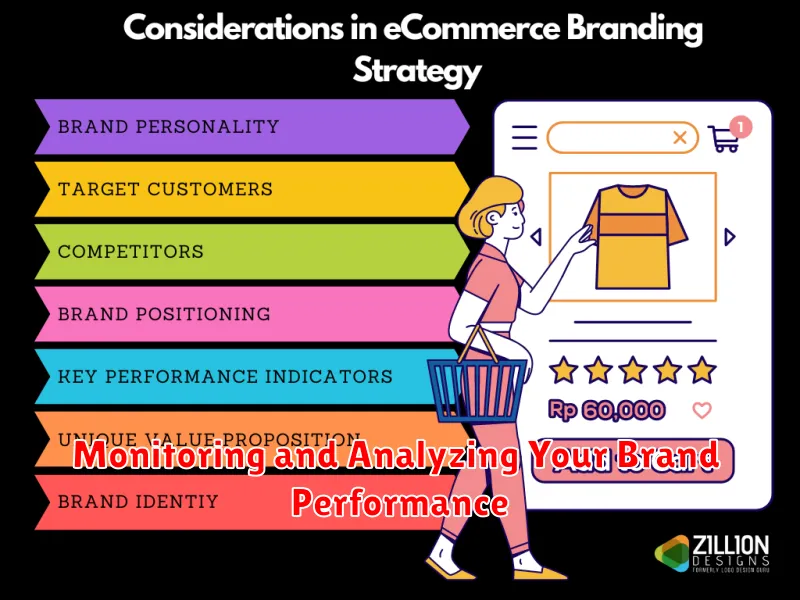In today’s digitally-driven marketplace, a powerful brand is essential for e-commerce success. This comprehensive guide will explore the crucial elements of building a brand within the e-commerce landscape. From defining your brand identity and understanding your target audience to leveraging digital marketing strategies and optimizing the customer experience, we’ll cover the key steps to establish a strong brand presence online and drive sustainable growth for your e-commerce business. Whether you’re launching a new venture or looking to revitalize an existing one, this guide offers valuable insights into crafting a brand that resonates with customers and sets you apart from the competition in the crowded e-commerce market. Learn how to harness the power of branding to build customer loyalty, increase sales, and achieve long-term success in the dynamic world of e-commerce.
This guide delves into the intricacies of e-commerce branding, providing practical strategies and actionable advice for cultivating a compelling brand narrative. We’ll examine the importance of consistent brand messaging across all e-commerce platforms, and discuss how to leverage social media, content marketing, and search engine optimization (SEO) to enhance brand visibility and reach your target audience. Discover how to create a seamless and engaging customer journey that fosters brand loyalty and drives conversions. This comprehensive guide offers a roadmap for building a powerful brand that not only attracts customers but also cultivates a community around your e-commerce business, ensuring its sustained growth and success in the competitive digital marketplace.
Understanding the Importance of Brand Building in E-Commerce
In the crowded digital marketplace, a strong brand is essential for e-commerce success. It’s more than just a logo; it’s the overall perception customers have of your business. Brand building fosters recognition, trust, and loyalty, setting you apart from the competition.
Why is brand building crucial for e-commerce? It directly impacts key business metrics. A recognizable brand attracts and retains customers, leading to increased sales and higher customer lifetime value. Furthermore, a strong brand can command premium prices, boosting profitability.
Brand building establishes trust, which is particularly critical in online transactions where customers can’t physically interact with products. A trusted brand provides reassurance and encourages conversions.
Finally, a well-defined brand simplifies marketing efforts. It provides a clear foundation for messaging and content creation, ensuring consistency across all platforms.
Defining Your Brand Identity and Values
A strong brand identity is the bedrock of success in the competitive e-commerce landscape. It’s what sets your business apart and resonates with your target audience. This involves defining your core values, brand personality, and unique selling proposition.
Core values represent the fundamental beliefs that guide your business decisions and actions. These values should be authentic and reflected in all aspects of your brand, from customer service to product development. Clearly defined values help build trust and loyalty with your customers.
Your brand personality gives your brand a human touch. Is your brand playful, sophisticated, or rugged? This personality should be consistent across all your online platforms. It’s what helps customers connect with your brand on an emotional level.
Finally, your unique selling proposition (USP) is what differentiates you from your competitors. What makes your products or services better or different? Clearly articulating your USP is crucial for attracting and retaining customers.
Creating a Compelling Brand Story
A compelling brand story is the narrative that connects your brand with your customers on an emotional level. It’s not just about what you sell, but why you sell it. This narrative gives your brand a personality, making it relatable and memorable.
Key elements of a compelling brand story include:
- Origin Story: How did your brand begin? What problem were you trying to solve?
- Mission and Values: What principles guide your business? What do you stand for?
- Brand Voice: What is the personality of your brand? Is it playful, serious, sophisticated?
- Customer Connection: How does your brand improve the lives of your customers?
Authenticity is paramount. Your story should be genuine and reflect the true essence of your brand. A contrived or inauthentic story will be easily detected by customers and can damage your brand’s credibility.
By crafting a compelling narrative, you can differentiate your brand from competitors, foster customer loyalty, and ultimately drive sales. This narrative should be woven throughout your website, marketing materials, and social media presence to create a cohesive and memorable brand experience.
Designing a Visually Appealing Online Store

A visually appealing online store is crucial for attracting and retaining customers. Aesthetics play a significant role in how customers perceive your brand and their overall shopping experience. A well-designed store communicates professionalism, trustworthiness, and reinforces your brand identity.
Choose a suitable theme. Your store’s theme should align with your brand’s personality and target audience. A clean, modern theme works well for tech products, while a rustic theme might be more appropriate for handcrafted goods.
Prioritize high-quality product photography. Professional product photos showcasing your offerings from different angles are essential. Consistent lighting and background create a unified and professional look.
Use whitespace effectively. Avoid cluttering your pages with too much content or imagery. Whitespace helps to create a clean and uncluttered look, making it easier for customers to navigate and focus on the products.
Ensure mobile responsiveness. In today’s mobile-first world, your online store must be easily accessible and functional on all devices. A responsive design automatically adjusts to different screen sizes, providing a seamless shopping experience.
Crafting High-Quality Product Listings that Reflect Your Brand
Your product listings are the digital storefront of your brand. Compelling and informative listings are crucial for converting browsers into buyers while simultaneously reinforcing your brand identity. Every element, from product titles to descriptions, should align with your brand’s voice and values.
Product titles need to be both descriptive and concise, incorporating relevant keywords for searchability. Accurately reflect the product’s features and benefits, using language that resonates with your target audience. Avoid generic or overly technical language.
High-quality product descriptions provide detailed information, highlighting key selling points and addressing potential customer questions. Incorporate your brand’s personality into the descriptions while maintaining a professional tone. Focus on benefits, not just features, explaining how the product solves a problem or improves a customer’s life.
Professional product photography plays a vital role. Images should be clear, well-lit, and showcase the product from multiple angles. Consistent styling and background choices will further enhance your brand’s visual identity across the platform.
Leveraging Social Media to Build Brand Awareness and Engagement
Social media is a powerful tool for building brand awareness and engagement. By strategically using different platforms, e-commerce businesses can connect with their target audience, foster a community, and drive sales.
Choosing the right platforms is crucial. Consider where your target audience spends their time. For example, visually-driven brands might prioritize Instagram or Pinterest, while businesses targeting professionals might find LinkedIn more effective.
Creating engaging content is key to capturing attention. This includes high-quality images, videos, and written posts that resonate with your audience’s interests and needs. Running contests and interactive polls can also significantly boost engagement.
Consistency is essential. Regular posting keeps your brand top-of-mind and fosters a sense of community. A consistent brand voice and aesthetic across platforms also reinforces brand identity.
Paid social media advertising can amplify your reach. Targeted campaigns allow you to reach specific demographics and interests, maximizing your return on investment.
Providing Excellent Customer Service to Foster Brand Loyalty
In the competitive e-commerce landscape, exceptional customer service is paramount to building a loyal customer base. Positive experiences foster trust and encourage repeat business, transforming one-time buyers into brand advocates.
Responsiveness is key. Address customer inquiries promptly and efficiently across all channels, including email, social media, and live chat. Personalized communication makes customers feel valued. Use their names and reference past purchases to show you recognize them as individuals.
Proactive support can prevent issues before they arise. Clear and concise FAQs, order tracking information, and easy return policies contribute to a seamless customer journey. When problems do occur, empower your customer service team to resolve them efficiently and fairly.
Go the extra mile. Consider offering exclusive discounts, personalized recommendations, or early access to new products for loyal customers. Collecting feedback through surveys or feedback forms demonstrates a commitment to continuous improvement and further strengthens the customer relationship.
Building an Email List and Engaging with Your Subscribers
A robust email list is a cornerstone of effective e-commerce branding. It provides a direct line of communication to nurture leads and build lasting relationships with customers.
Growing your list requires strategic opt-in forms. Place them prominently on your website, offering valuable incentives such as exclusive discounts, free shipping, or downloadable content in exchange for email addresses. Ensure compliance with data privacy regulations and clearly communicate how subscriber data will be used.
Engaging subscribers involves delivering valuable content consistently. Tailor email campaigns to specific customer segments and preferences. Consider personalized product recommendations, helpful tips related to your niche, and exclusive previews of upcoming sales or promotions.
Analyzing email performance is crucial. Track metrics like open rates, click-through rates, and conversion rates to understand what resonates with your audience. Continuously refine your email strategy based on data insights to optimize engagement and maximize your return on investment.
Monitoring and Analyzing Your Brand Performance

Monitoring and analyzing your brand’s performance is crucial for long-term success in the e-commerce landscape. This involves tracking key metrics to understand how your brand is perceived and how effective your strategies are.
Key Performance Indicators (KPIs) provide quantifiable data that reflects your brand’s health. These metrics might include:
- Website Traffic: Monitor the number of visitors to your website and identify their sources.
- Conversion Rates: Track how many visitors complete desired actions, such as making a purchase or signing up for your email list.
- Social Media Engagement: Analyze likes, shares, comments, and follower growth across your social media platforms.
- Customer Satisfaction: Gauge customer happiness through surveys, reviews, and return rates.
- Brand Mentions: Track how often your brand is mentioned online, both positively and negatively.
By regularly reviewing these KPIs, you can identify areas for improvement and adjust your strategies accordingly. Utilizing analytics tools and dashboards can streamline this process and provide valuable insights into your brand’s performance.

